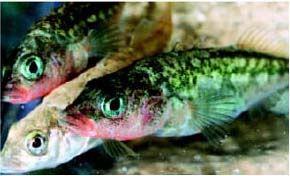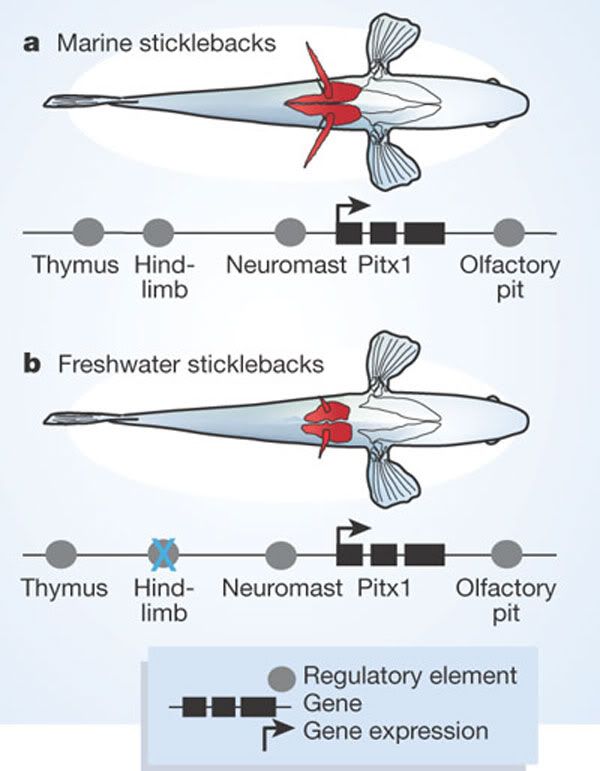Tuesday, March 29, 2005
More Fishiness
At the risk of seeming a little too post-modern I'm going to open this post with some self-referentiality:
"Nevertheless this little self inflating fish, along with a number of its piscine brethren, are teaching us a lot about how we work and how we got here in the first place."
That's from the Fugu article I posted last week. You see I left that little teaser about "a number of its piscine brethren" in because I wanted to talk about a little fish called the Three Spined Stickleback. Then, before I even start to write about them, World Wide Rant notes a whole bunch of new and interesting stuff has been published about them. So, before we get to the new stuff let's start from the start and see what the sticklebacks have to teach us.

Sticklebacks like those you see above represent an evolutionary experiment. They are generally marine fish that sport impressive bony armour plates to protect them from predators. That started to change a little 10 000 years ago when the last ice age gave up its icy grip on the planet. Many glaciers in the Stickleback's range thawed, generated new rivers and lakes. Since the sticklebacks tend to spawn in freshwater they were in the perfect position to find out and exploit these new environments.
In the ensuing 10 000 years many very divergent populations of sticklebacks have turned up. One can find freshwater sticklebacks over four times the size of their marine counterparts, and many that are significantly smaller. In fact, the populations are so different that at one stage naturalists split what are now considered one species into 40 different ones. One recurring feature in stickleback evolution has been the loss of armour plating and the three spines that give the fish their name. As I mentioned earlier in the ocean these plates serve as protection from predators but in many rivers and lakes there is simply no need for such protection and selection can favour those that don't invest in it. In fact, the spines that protrude from their pelvic fin may even serve as a target by which predatory invertebrates can grab a hold.

Last year researchers from Stanford lead by Michael Shapiro compared the genomes of spiked and spikeless sticklebacks to see what made them different. What they found was fascinating. The spikeless sticklebacks don't have any genes that their spikey equivalents don't; or miss any that the others have. They don't even have any differences in the actual protein-coding bit of one of their genes. In fact the strongest difference between the two groups is in the presence or lack of one promoter in one gene. Promoters are small pieces of DNA in and (more commonly) around a gene that act as on/off switches. Vertebrate genomes tend to have very deft control over their genes, being able to turn them on or off in specific tissues at specific times. The difference between the two groups of sticklebacks lie in one, tissue specific promoter in a gene excitingly named Pitx1

The above grpahic is from Sahpiro's paper in Nature. As you can see Pitx1 has four differentpromoters, each for specific tissues. In the spikeless sticklebacks one such promoter has undergone a mutation leaving it ineffective. In other words a mutation in one small piece of DNA related to one gene can cause such a major morphological change that a fish looses its defining characteristic. I'm going to lose even more credibility and quote myself again:
Fugu and the other genome projects have taught as that a lot of evolution has had nothing to do with what genes one has, but how one uses them. Sure gene and genome duplications have created more genes for selection to work on but just as importantly evolution has lead to novel expression of existing genes.
And here is an exciting example of just that. A new expression pattern in one gene can lead to a new, advantageous morphology. The other thing that the stickleback's story tells us is how quick evolution can happen. The freshwater sticklebacks have had just 10 000 generations to adapt to their new lifestyles but have in that time achieced major morphological change. And that's where the new publication comes in.
Sadly the new paper is published in Science - a journal with a bizarre subscription policy that means I can't read the paper even through the university's proxy - so I'm just going of press releases and (hopefully) good media coverage for most of this. The Stanford team have not rested on their laurels; rather they have investigated what genes are involved in making the bony plates that serve as armour in marine sticklebacks. And surprise surprise it's one gene that makes the difference between the fully armoured ocean dwelling sticklebacks and the lithe freshwater ones. The gene in question is called Eda and is well known to students of human developmental biology because it plays an important role in our embryology, helping to define cells that will give rise to hair, teeth and sweat glands.
But here's the really interesting bit. In the wild, ocean dwelling, bony populations there is almost no variation in their Eda genes but all the freshwater populations that have given up their armour - from the USA to Iceland - have mutations in the same region of the Eda gene. That is to say, it is very unlikely the mutation existed in the fish that founded the freshwater populations. Rather, in the space of a mere 10 000 generations populations of sticklebacks the world over have repeteadly generated the necessary mutations and undergone the necessary selection to generate the very different morphologies seen in wild populations today. Not only are sticklebacks an experiment in evolution, they are a repeatable one.
Sticklebacks provide us with a captivating story of evolution on the fine scale. We live in exciting times. For the first time in history we can trace the very small changes in a species' genes that can give rise to very major changes in that species.












